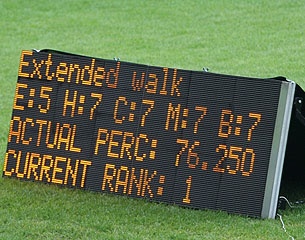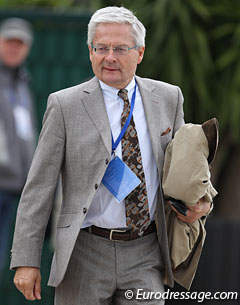
The 2017 FEI General Assembly in Montevideo, Uruguay, has voted in favour to the Dressage Judging Working Group's proposal to remove three of the four collective marks on dressage score sheets as of 2018.
Recommendation from the Dressage Judges Working Group
In their official proposal report published in August 2017, the DJWG stated that:
With the possible exception of the Rider/Aids mark, the DJWG feels that the collective marks are already taken into account in the movement scores. The switch of emphasis from a movement mark - based on exactly what the judge sees at the moment of execution - to a collective note that is designed to summarize the entire test, does not aid the judge’s focus.
Statistical analyses of the collective marks in tests from 2017 and in particular from the 2017 World Cup Finals in Omaha have proven that the top scoring, big names riders get an extra score boost from the judges in their collective marks.
"While technical and collective scores are quite correlated, the riders at the top of the ranking do typically receive an extra boost from the collective marks. We also observe that even in some high level events the ranking of the technical marks is effectively overruled by that of the collective marks," the report stated, based on analyses by FEI statistician David Stickland.
By removing three of four collectives, judges will get less opportunity to influence the overall score at the end of the score sheet.
The DJWG also saw a time advantage in removing the collectives: "The completion of the collective marks also takes time between starters and, particularly for televised events, a small gain in overall competition time can be expected if collective marks are no longer used."
FEI General Assembly Votes in Favour of Removing Three Collective Marks

The General Assembly approved modifications to the Dressage Rules including the introduction of a Medium Tour Freestyle test and the removal of the collectives.
The General Assembly voted separately on the proposed change to collective marks – the removal of marks for Paces, Impulsion and Submission and replaced with one single criteria for the Athlete's position and seat; correctness and effect of the aids. This was approved, with five National Federations voting against and two abstentions.
Germans Disgruntled about the Decision
When the news became public that the collectives were removed, the typical reaction of outrage and disbelief arose, even though very little lobbying and campaigning, let alone public discussion, had been done carried out against the proposal. The dressage world seemed so busy fighting off the HiLo drop that they forgot to care about the collectives.
Especially in Germany a fierce disagreement with this decision was published with headlines that "international dressage sport is moving in the wrong way."
Dressursport Deutschland, the official platform for the German elite squad dressage riders and its selection committee, posted reactions from German team trainer Monica Theodorescu and German 5* judge Dietrich Plewa.
"The scratching of the collectives is my opinion a very bad idea," said Theodorescu. "I had already expressed my opinion beforehand to the IDTC that I didn't like it. The collectives are essential to highlight the value of the principles of dressage. The judge gets the opportunity to weigh the rider's focus positively or negatively. Whether is the clarity of gaits, the throughness, the connection, the activity from behind and much more. I hope that because of this change we won't return to seeing horses who are not loose, nor relaxed and lack natural expression."
 Judge Plewa said he was surprised that the GA voted to remove the collectives and rather had preferred to have seen the coefficient to the aids and seat collective removed. Plewa admits that judges have used this collectives as an opportunity to influence the overall score. "Not infrequently a rider benefits from his name on this note," said Plewa. "I find the rider/seat score important, but in comparison with the other collectives, this score is of little significance.
Judge Plewa said he was surprised that the GA voted to remove the collectives and rather had preferred to have seen the coefficient to the aids and seat collective removed. Plewa admits that judges have used this collectives as an opportunity to influence the overall score. "Not infrequently a rider benefits from his name on this note," said Plewa. "I find the rider/seat score important, but in comparison with the other collectives, this score is of little significance.
Plewa regrets the removal of the collective for paces. "Especially the score for clarity of gaits is particularly valuable. For instance, when a horse shows mistakes in the rhythm in the test, which are not enough to eliminate the horse, then we could have expressed our remarks on balance and clarity in that collective mark."
The German judge regrets the loss of the collective mark for submission. "Often we see horses that don't make technical mistakes, but that execute the movements in a mechanical way and don't swing through the body," Plewa explained. "We don't want that. We can rely on the collective mark for submission. Contact is often a point of discussion. When horses are too tight in the neck, the figure scores are often not sufficient. With the collective mark for submission we can stress that we don't tolerate contact issues and tight necks."
Collectives Echo What Needs to Be Judged in Figure Scores
Plewa certainly makes valid points about submission, throughness and clarity of gaits, but these criteria can and should be scored in each figure score. If a horse is uneven in the extended trot, but not lame, the figure score should go down. If the horse moves mechanically in a half pass, the figure score for half pass should go down. If the horse is tight in the neck and not through in a movement, that score should go down. The collectives need to be addressed in each of the figure scores and not repeated at the bottom where judges have the opportunity to influence the score in whichever way they want.
The collective for rider's seat and aids has always been a puzzling mark with big name riders who sit deadstill in the saddle but their horses have tongues half sticking out, jaws crossed, and nosebands cranked getting consistent nines for seat and aids.
David Stickland told Eurodressage that, "personally I had proposed scrapping them all as they also firstly introduce a place for the judges to get back into line again. I also showed that they (disproportionally?) favour the top riders."
by Astrid Appels
Related Link
Dressage Judging Working Group Makes Recommendations for 2018 Rule Amendments